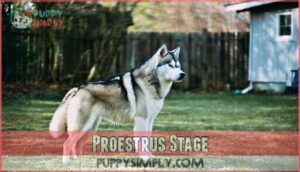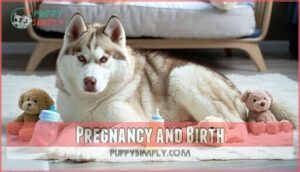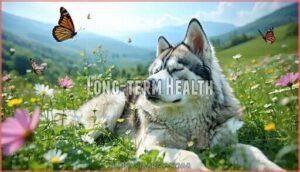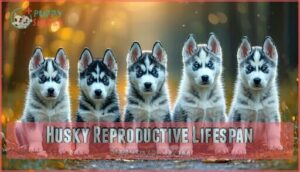This site is supported by our readers. We may earn a commission, at no cost to you, if you purchase through links.

Female huskies typically start their first heat cycle around 6-12 months and can continue reproducing until they’re 8-10 years old. However, most responsible breeders retire females by age 6-7 to protect their health.
Males can technically breed throughout their lives but fertility peaks between 1-5 years.
The reproductive window isn’t just about age – genetics, health, and proper care play vital roles in determining how long do huskies reproduce effectively.
Quality breeding focuses on the dog’s wellbeing rather than maximizing litters, which naturally extends their healthy reproductive years.
Table Of Contents
- Key Takeaways
- Husky Reproduction Basics
- How Long Huskies Reproduce
- Husky Heat Cycle Phases
- Factors Affecting Reproduction
- Female Husky Reproductive Health
- Responsible Breeding Considerations
- Husky Reproductive Lifespan
- Frequently Asked Questions (FAQs)
- What is the leading cause of death in Huskies?
- How can I determine the size and weight of my Husky as it grows?
- What factors contribute to the color of a Husky’s eyes?
- Are Huskies known for growing rapidly in their first year?
- How can I ensure my Husky is in optimal health for breeding?
- Can spayed huskies still show heat behaviors?
- Do male huskies have breeding season limits?
- How does climate affect husky reproduction timing?
- Can huskies breed with other dog breeds?
- What medications interfere with husky fertility?
- Conclusion
Key Takeaways
- You’ll have 8-10 years of breeding potential – Female huskies can reproduce from their first heat cycle (6-12 months) until around 8-10 years old, though most responsible breeders retire them by 6-7 years to protect their health.
- Your husky’s peak fertility window is narrow – Females are most fertile between 2-5 years old, with optimal breeding occurring during days 10-14 of their heat cycle, which happens twice yearly.
- You shouldn’t rush early breeding – Wait until your female husky is 18-24 months old before first breeding to ensure complete physical development and reduce health complications for both mother and puppies.
- Your dog’s genetics and care determine reproductive success more than age – Quality breeding focuses on genetic screening, proper nutrition, regular health check-ups, and responsible practices rather than maximizing the number of litters throughout their reproductive years.
Husky Reproduction Basics
When you’re planning to breed your husky, you’ll need to understand their reproductive timeline starts around 6 months of age.
Female huskies enter their first heat cycle between 6-12 months, but responsible breeding should wait until they’re at least 18-24 months old for ideal health and safety.
Heat Cycle Duration
During your husky’s reproductive years, her heat cycle lasts approximately three weeks and occurs twice yearly.
This cycle length affects her husky reproductive health and determines breeding opportunities throughout her husky reproduction lifespan.
- Cycle Length: Each heat duration spans 2-3 weeks every six months
- Bleeding Duration: Initial bleeding occurs for 7-10 days during proestrus
- Standing Heat: Final phase when she’s most receptive to mating
The husky heat cycle’s timing creates specific windows for breeding decisions.
Fertility Window
During your female husky’s fertility period, the ideal mating window occurs between days 10-14 of her heat cycle.
You’ll notice receptivity signs like standing heat, where she’ll hold her tail to the side when touched.
Proper cycle monitoring helps determine the best breeding timing, watching for decreased bleeding and a more receptive attitude toward males during this vital canine fertility phase, which is crucial for successful breeding timing.
Breeding Age
Timing matters when breeding huskies. You’ll want to wait until females reach ideal age of 18-24 months, allowing complete physical development before their first litter.
Male maturity occurs around 6-12 months, but fertility improves with age. Early husky breeding age increases breeding risks like health complications and reduced puppy survival rates.
Proper timing during the husky fertility period protects the female husky breeding cycle and supports healthy reproduction throughout their lifespan impact years. Prioritize pre-breeding health checks to minimize genetic risks, ensuring a healthy reproduction and considering the breeding risks to support the female husky.
How Long Huskies Reproduce
Understanding your female husky breeding timeline helps you plan responsibly for your dog’s reproductive years.
Most female huskies can safely reproduce from their second heat cycle (around 18-24 months) until approximately 5-6 years old, when reproductive decline begins.
Older females can face challenges with pregnancy, so ethical breeders consider fertility decline risks.
Here’s what you need to know about husky breeding lifespan:
- Fertility window: Peak breeding years span roughly 4-5 years for females
- Cycle frequency: Heat cycles occur twice yearly, providing two breeding opportunities
- Optimal litters: Most breeders limit females to 4-5 litters maximum for health
Your husky’s breeding cycle follows a predictable pattern throughout her reproductive years.
Female husky breeding should focus on the prime fertility period when complications are lowest.
The husky heat cycle remains consistent during these years, but fertility gradually decreases after age six.
Professional breeders typically retire females around this age to prevent health risks associated with older pregnancies.
Male huskies maintain fertility much longer, often reproducing into their senior years if healthy.
Husky Heat Cycle Phases
Understanding your husky’s heat cycle phases helps you track her reproductive timeline and make informed breeding decisions.
Each phase brings distinct physical and behavioral changes that signal where she’s in her fertility window.
Proestrus Stage
The initial phase kicks off with unmistakable changes as your female husky’s body prepares for potential breeding. During this seven to ten-day period, you’ll notice clear signs that shouldn’t be ignored.
The signs can be categorized into physical and behavioral changes, which are outlined in the following table:
| Physical Signs | Behavioral Changes | Timeline |
|---|---|---|
| Vulva Swelling begins | Increased urination frequency | Days 1-3 |
| Light bleeding starts | Mood changes appear | Days 4-7 |
| Discharge becomes noticeable | Mating Rejection occurs | Days 7-10 |
Proestrus Duration varies slightly between individual dogs, but the Bleeding Intensity typically remains light during these early heat phases. Your husky will show clear Behavioral Changes, including restlessness and frequent licking. Despite male interest, she’ll firmly reject any mating attempts – this isn’t the fertile window yet.
Estrus Stage
After proestrus ends, your female husky enters estrus, the true fertile stage.
This phase lasts 5-10 days when she’s most receptive to mating. You’ll notice her discharge color changes from bright red to brown or pinkish.
Behavioral changes include seeking male dogs and raising her tail when approached – this is called standing heat.
During these fertile days, successful husky breeding typically occurs, and it is crucial for the breeding process to happen within this fertile stage.
Diestrus Stage
After your husky’s estrus stage ends, she’ll enter diestrus, which lasts 10 to 140 days.
During this phase, hormone levels stabilize and uterine changes occur as her body returns to normal.
You might notice behavior shifts as she becomes less interested in males, and some female huskies experience false pregnancy symptoms during diestrus. This cycle length varies between individual dogs.
Anestrus Stage
After diestrus ends, your husky enters anestrus – the quiet resting phase.
This canine anestrus period lasts several months with no reproductive activity or behavioral changes.
Her hormonal balance stabilizes during this husky reproductive cycle stage, and no cycle interruption occurs naturally.
This reproductive health recovery time prepares her body for the next heat cycle, maintaining ideal duration factors for future breeding readiness.
Factors Affecting Reproduction
Several factors determine how successfully and how long your husky can reproduce throughout their lifetime.
Your dog’s genetics, nutrition, health care, and breeding practices directly impact their reproductive span and overall fertility success.
Genetics and Lineage
Your husky’s genetic background shapes their entire reproductive journey.
Genetic screening reveals heritable traits that affect fertility, while lineage tracking helps maintain breed standards.
Strong genetic diversity in breeding huskies reduces health risks and improves reproductive success.
Smart breeders study family lines to predict breeding outcomes and avoid genetic problems that could shorten reproductive years.
Understanding inherited traits can provide clues about a puppy’s future temperament and help identify potential issues related to their reproductive journey.
Nutrition and Diet
Proper nutrition substantially impacts your husky’s reproductive success throughout their breeding years.
Quality dietary needs during pregnancy diet phases and lactation support directly affect husky litter size and puppy development outcomes.
Huskies also need proper grooming, so use vet-approved ear cleaner to maintain ear hygiene.
- Protein Requirements: Feed 25-30% high-quality animal protein to support muscle mass and reproductive function during husky pregnancy duration
- Essential Fats: Provide 15-20% fat content with omega-3s to balance hormones and improve ovulation rates
- Micronutrient Balance: Include vitamins A, D, E, and minerals like calcium for healthy embryonic development and puppy nutrition
- Feeding Schedule: Offer small, frequent meals during pregnancy and lactation to maintain glucose levels and support puppy feed phases
Health Check-ups
Regular veterinary care keeps your breeding program healthy and successful.
Schedule thorough physical examinations before each husky heat cycle to assess reproductive health.
Your vet will check vaccination status, perform genetic screening for hip dysplasia and eye disorders, and implement parasite control measures.
These health check-ups identify potential issues early, ensuring ideal husky pregnancy outcomes and protecting both mother and puppies throughout the reproductive process.
They are crucial for the health and success of your breeding program, making regular veterinary care essential.
Breeding Practices
Following your husky breeding tips means establishing consistent practices that protect both parents and puppies.
You’ll need genetic screening for hip dysplasia and eye disorders before stud selection.
Maintain proper breeding frequency—once yearly maximum—while creating a safe whelping environment.
Focus on early puppy socialization and monitor for common husky breeding problems throughout the breeding season.
Female Husky Reproductive Health
When you’re considering breeding your female husky, understanding her reproductive health becomes essential for successful outcomes.
This includes knowing what to expect during pregnancy, how to provide proper postpartum care, and maintaining her long-term reproductive wellness throughout her breeding years.
Pregnancy and Birth
When your pregnant husky reaches her 63-day gestation timeline, watch for key whelping signs that indicate labor’s approaching.
You’ll notice her temperature dropping and restlessness increasing as birthing complications become possible. A reliable pregnancy test can offer early confirmation.
- Temperature drops to 99°F approximately 24 hours before whelping
- Labor progresses through two distinct stages over 6-22 hours total
- Litter size typically ranges from 4-8 puppies per delivery
- Puppy care begins immediately with membrane removal and breathing stimulation
- Monitor for prolonged contractions or dark discharge indicating husky whelping emergencies
Postpartum Care
After delivery, your husky’s body works overtime to produce milk and recover from whelping.
Monitor her closely for infection signs like fever or unusual discharge. Increase her food by 50-100% during lactation to support milk production and maternal nutrition.
See options for specialized postpartum diets to aid recovery. Watch newborn care basics and track husky puppy development milestones.
| Care Aspect | Timeline | Key Actions |
|---|---|---|
| Feeding | First 24-48 hours | Increase calories by 50-100% for milk production |
| Health Monitoring | Daily checks | Watch for mastitis, fever, or abnormal discharge |
| Puppy Weaning | 4-6 weeks | Gradually switch puppies to solid food |
| Exercise Resumption | 2-3 weeks post-birth | Start with short, gentle walks only |
Long-term Health
Beyond the breeding years, your husky’s reproductive health directly impacts her overall well-being and lifespan factors.
Spaying eliminates cancer risks from ovarian and uterine tumors while preventing pyometra, a life-threatening infection affecting up to 23% of intact females.
This procedure supports joint health, heart health, and immune system function throughout her golden years, extending her canine reproductive cycle safely.
Responsible Breeding Considerations
You must approach husky breeding with careful planning and a commitment to the breed’s health and welfare.
Finding suitable homes for puppies requires screening potential owners to guarantee they understand husky exercise needs, temperament, and long-term care requirements, ensuring a good match for both the puppy and the owner, which is crucial for the puppy’s welfare.
Ethical Breeding
You’ll want to choose breeders who prioritize genetic screening and health guarantees over quick profits.
Responsible breeding practices include thorough DNA testing, proper puppy socialization periods, and lifetime breeder responsibility commitments that protect both dogs and future families.
- Genetic screening prevents heartbreaking hereditary diseases in your future puppy
- Health guarantees provide peace of mind during those precious early years
- Informed consent guarantees you understand the husky breeding season timeline completely
- Proper breeding practices create healthier, happier dogs for responsible ownership
Proper breeding practices are essential for the well-being of the dogs, and by choosing a responsible breeder, you can ensure that your future puppy will have a healthier and happier life with health guarantees and proper breeding practices.
Puppy Placement
Finding the right homes for husky puppies requires careful adoption screening and thorough evaluation of each family’s home environment.
You’ll need to assess potential owners’ experience with husky puppy care, their training commitment, and ability to provide proper puppy socialization.
Successful breeding huskies guide emphasizes ongoing support for new families, ensuring each husky puppy thrives in their forever home.
Prospective owners should understand the importance of being a responsible dog owner.
Husky Reproductive Lifespan
Your husky’s reproductive lifespan typically spans from 6 months to about 8-10 years of age.
Understanding this reproductive timeline helps you make informed decisions about breeding, spaying, or managing your dog’s reproductive health throughout their life.
Age Range
Female huskies reach puberty onset around 6-12 months, but breeding maturity shouldn’t occur until 18-24 months.
Their ideal age for reproduction spans 2-5 years, when conception rates peak.
After age 6, reproductive decline begins with irregular cycles and fertility issues, leading to health risks, so responsible breeders retire females by then.
Reproductive Cycle Length
Your husky’s reproductive cycle length varies substantially based on individual differences and environmental factors.
Most huskies experience heat cycles every six months, but cycle variations can range from four to eight months between cycles.
Key factors affecting your husky’s cycle timing include:
- Seasonal impact – Many huskies cycle more frequently during spring and fall months
- Hormonal influence – Individual hormone levels create unique timing patterns for each dog
- Environmental factors – Stress, nutrition, and living conditions affect cycle regularity
- Age-related changes – Younger and older huskies show more irregular cycle spacing
- Breed genetics – Some husky lines naturally have longer or shorter intervals between cycles
The husky heat cycle typically lasts 21 days, with the husky gestation period averaging 63 days when breeding occurs during husky reproductive stages.
Owners should also be aware that huskies are known for their friendly and playful nature.
Litter Size Impact
Litter size directly impacts your husky’s reproductive lifespan and maternal health.
Genetic Influence plays a vital role in determining pregnancy outcomes, while proper Nutritional Needs support both mother and husky puppy development during the husky gestation period.
| Litter Size | Maternal Health Impact | Puppy Survival Rate |
|---|---|---|
| 3-4 puppies | Excellent recovery | 95-98% |
| 5-6 puppies | Good condition | 90-95% |
| 7-8 puppies | Increased stress | 80-90% |
| 9+ puppies | High risk | 70-80% |
Larger litters strain female husky fertility and require extended Litter Spacing between pregnancies in huskies for ideal recovery.
Frequently Asked Questions (FAQs)
What is the leading cause of death in Huskies?
Age, cancer, and accidents stand as the three leading killers.
Cancer is the leading cause of death for Huskies, particularly affecting senior dogs due to their longer lifespans compared to other breeds.
How can I determine the size and weight of my Husky as it grows?
Track your Husky’s growth by weighing them weekly and measuring height at the withers. Compare measurements to breed standard charts. Males typically reach 45-60 pounds, females 35-50 pounds by maturity.
What factors contribute to the color of a Husky’s eyes?
Your Husky’s eye color depends on genetics, specifically melanin production.
Dominant genes create brown eyes, while recessive genes produce blue.
You’ll notice mixed colors when both gene types interact, creating striking heterochromia patterns.
Are Huskies known for growing rapidly in their first year?
Yes, you’ll find that Huskies experience remarkable growth spurts during their first year.
They’ll typically reach about 80% of their adult size by twelve months, with most rapid development occurring between three to eight months of age, which is a period of rapid development.
How can I ensure my Husky is in optimal health for breeding?
Schedule thorough veterinary exams including genetic testing for hip dysplasia and eye conditions.
Maintain proper weight through quality nutrition and regular exercise.
Verify vaccinations are current and conduct parasite screenings before breeding to maximize your dog’s reproductive health.
Can spayed huskies still show heat behaviors?
Spaying completely removes ovaries and uterus, eliminating hormone production that drives heat behaviors. You won’t see typical heat signs like bleeding, swelling, or increased affection-seeking after proper spaying surgery.
Do male huskies have breeding season limits?
Like a year-round athlete, male huskies don’t have breeding season limits and can mate throughout the year if healthy.
However, you should limit breeding to prevent exhaustion and maintain peak fertility.
How does climate affect husky reproduction timing?
Climate doesn’t substantially affect husky reproduction timing since they’re adapted to harsh conditions.
Your husky’s heat cycles remain consistent year-round, occurring every six months regardless of seasonal temperature changes or weather patterns, which makes their reproduction timing quite consistent.
Can huskies breed with other dog breeds?
Yes, you can absolutely breed huskies with other dog breeds to create mixed offspring.
These crossbreeds inherit traits from both parents, combining husky characteristics with features from the other breed for unique, often healthier puppies.
What medications interfere with husky fertility?
Certain medications can reduce your husky’s fertility, including steroids, chemotherapy drugs, some antibiotics, and hormonal treatments.
Anti-seizure medications and NSAIDs may also affect reproductive function.
Always consult your vet before breeding.
Conclusion
Sarah’s champion husky, Luna, retired from breeding at age 7 after producing healthy litters for five years.
Understanding how long do huskies reproduce helps you make informed breeding decisions.
Female huskies typically reproduce from 6-12 months until 6-8 years old, while males remain fertile longer.
Genetics, health, and responsible practices determine reproductive success more than age alone.
Prioritizing your husky’s wellbeing over profit guarantees healthier breeding outcomes and extends their quality reproductive years effectively, which is crucial for their overall quality of life.
- https://worldofdogz.com/husky-breeding-age/
- https://paworigins.com/blogs/vet-blogs/understanding-life-expectancy-for-huskies-care-and-longevity-tips
- https://everfur.com/blogs/news/how-long-do-huskies-live
- https://vetic.in/blog/breed/the-husky-breed-comprehensive-care-nutrition-training-and-vaccine-guide-for-huskies/
- https://www.americanbreeder.com/resources/american-breeder-blog/dogs/best-supplements-reproductive-health-breeding-dogs

















